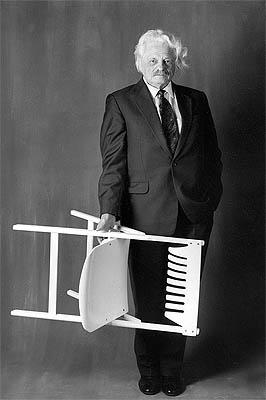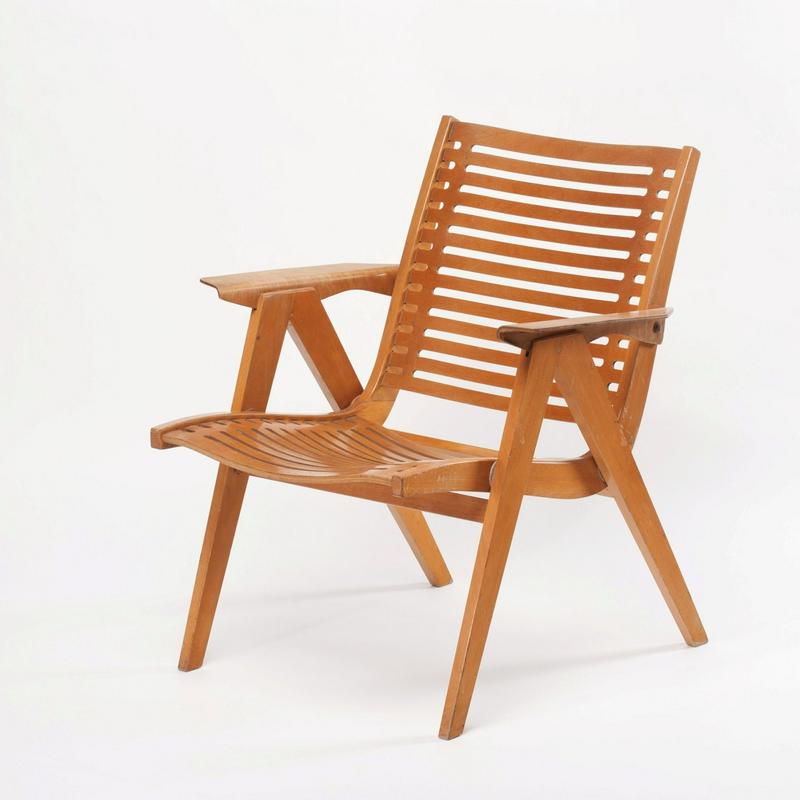
Swedish professor Erik Berglund wrote in the Swedish newspaper Dagens Nyheter in 1960 that Niko Kralj was the best furniture designer in Europe at that time.
The Rex chair, which is the most well-known, was not developed overnight. Kralj developed that chair over four years; he thus had a lot more time and funds to develop the most beautiful and suitable model.

The Rex chair is also part of the collections of Designmuseum Danmark, MuseumsQuartier in Vienna and the Museum of Decorative Arts in Prague. According to the selection of the Slovenian newspaper Finance in 1999, the Rex chair won second place as the best Slovenian product of the 20th century. Kralj’s practical solutions found their way into numerous Slovenian homes in the second half of the 20th century, and are now on the wish list of lovers of high-quality design around the world.
Assistant Professor Dr Jasna Hrovatin described his life and design achievements in the scientific monograph Niko Kralj. We talked about Kralj’s work, knowledge, way of thinking and the mark he left in the Slovenian design.
Why is Niko Kralj considered a phenomenon in the Slovenian design?
Kralj is considered the originator of design in Slovenia, or in the former Yugoslavia. In 1952, he started working in Stol, where he established the first development department and design office in Yugoslavia and became its head. The purpose of the design office was to break through with one’s own idea and raise the level of design in the company and broadly at the national level. In 1957, he went on a six-month training course in Stockholm, where he became acquainted with Scandinavian design culture, which had a great influence on his approach to design and as a result on the development of design in Slovenia.
Kralj was at his creative peak at that time. He received numerous awards at international tenders and exhibitions, and he was still very young, aged 35. Swedish professor Erik Berglund wrote in the Swedish newspaper Dagens Nyheter in 1960 that Niko Kralj was the best furniture designer in Europe at that time. On another occasion, he said, “If Yugoslavia had at least five Niko Kralj it would be a design superpower.” At this point, it should be mentioned that Kralj cooperated with world-famous designers like Charles and Ray Eames, Richard Buckminster Fuller, Olaf Pira and Ferdinand Kramer. He also received many awards at home. He was particularly honoured to receive the highest Slovenian recognition in the field of culture in 1962, the Prešeren Award, for his achievements in design and architecture.
You also worked with him. In what way does he seem special to you personally?
In my opinion, Niko Kralj was an exceptional designer and I hold him in high regard. I particularly respected his dedication to work, his understanding and democratic attitude to his colleagues and students, his infectious enthusiasm about new ideas, and his ability not to force his opinion on others, but always to motivate us, students and colleagues. It was through motivation that he always excited us with his suggestions and ideas. He helped young designers acquire the confidence to present their design ideas. We agreed on who would do what, and he trusted us. It was very nice working with him. In spite the fact that he was a great designer, he always advocated teamwork. He was convinced that one person could not know everything and so he always cooperated with experts from different fields. I enjoyed working with him.
So you decided to write a book about him?
I was his student and he was my mentor for my diploma and Master’s thesis. I also began writing my doctorate under his mentorship, which I later concluded under another mentor, since Kralj had retired. Niko Kralj never wrote about himself, but he wrote many articles, and I thought that it would be a pity if that was lost, because his creative work was very rich and inspiring. Additional motivation also came from his daughter Veronika. Unfortunately, Kralj was already very ill when the book was published; he was 90 years old.
What is emphasised in the book?
As a designer, I find his principles of design the most important, and also the historical aspect.
Which achievements in design should be highlighted in particular?
Niko Kralj was a typical industrial designer. His work could be roughly divided into the period when he worked for Stol, where he mainly focused on designing chairs, and the period when he dedicated most of his time to developing wardrobe furniture systems. Kralj developed his products; his goal was to design his own brand.
From the chairs, I would highlight the Rex chair above all; its development started at Stol in 1952 and, in 1953, the first stacking Rex chair was manufactured. The folding Rex chair as we know it today was made in 1956. The first Shell chair appeared in 1956 and acquired its final shape in 1959. With this chair, Kralj focused on the design challenge of how to use two equally curved boards or the same shape for the seat and the back of the chair. He considered the formation of the base, the shell, and so on. The Mosquito 1953 chair has an originally designed seat made of two curved boards set in the notch of a bent element made of plywood, which also supports the back. All three chairs, including the chair with the cross-connection, are manufactured by the company Impakta, which sells Kralj’s products under the brand Kralj Rex.
The most important achievements in the field of furniture systems include the Futura furniture system (1973), which enabled exceptional componibility and the composition of an unlimited number of different pieces of furniture and elements of interior furnishing. Systemic furniture was upgraded with modularly dimensioned furnishings, such as glass and ceramic dishes and pillows. The system’s elements, i.e. universal edge and corner connections, modular plates and load-bearing connecting elements, allowed the composition of different objects, from furniture, lights, toys, façade elements and even pavilions.
However, the system not only enabled the composition of an unlimited number of different solutions, but also transformations of already used pieces of furniture into new pieces with different functions. The design thus facilitated people’s wish to change their living and working space. The purpose of the concept was that furniture would in a way grow with the ever-changing needs of users. The system was also designed to be accessible to those with the lowest incomes, while the more expensive variant with high-quality materials meet the requirements of the most demanding clients. The Savinja system from 1974 is an element system that also avoids the duplication of sides.
Who was the greatest influence on Niko Kralj?
It is difficult to speak of people; it is more sensible to talk about styles. The influence of modern design can be seen in Kralj’s rational aesthetics and production and the adjustment to technologies and new materials. Kralj also had a special relationship with wood, which was undoubtedly the influence of Scandinavian design and the family joinery tradition. But above all, Kralj was in favour of functionalism in the broadest meaning of the word: not only concerning the functionality of the product; he also pursued aesthetics as a function, in the belief that an aesthetic object affects the psyche of the user and thus their well-being, which he believed was also a certain type of function. It was also very typical of him to strive for the products to be as cost-effective as possible, which was logical, since purchasing power after the war was limited.
What status did Kralj have in the former Yugoslavia?
At home and abroad, Kralj applied for and registered 118 patents and models and produced 39 research essays. He was an innovator and inventor in various fields, but he particularly specialised in the construction and rationalisation of production. In 1975, he received the Boris Kidrič Fund Award for his inventions.
Where can his influence on young designers be noticed?
His design principles – seeking problems and functionality, innovativeness, interdisciplinary teamwork, the use of natural materials, especially wood, the use of new materials and new technologies and the adjustment to the needs of society – are still topical today.
Why does Slovenian design no longer have the same status?
Niko Kralj was a designer in a period of large furniture companies, such as Brest, Marles, Meblo, Stol and Alples. These used to employ over 40,000 workers, which was almost one-tenth of the entire Slovenian workforce. Designers at that time could still develop their own brands; today, investments in development are decreasing due to the lack of financial resources. A certain, already developed model is usually further developed. The Rex chair, which is the most well-known, was not developed overnight. Kralj developed that chair over four years; he thus had a lot more time and funds to develop the most beautiful and suitable model.
The Month of Design and the Furniture Fair took place a while ago. Did you visit them?
The production of furniture in Slovenia reflects the current state; there are no great offers. The Month of Design definitely gives hope that design still has a future in Slovenia.
What guides you when lecturing young designers, your students?
I have to stress again that to me, personally, Niko Kralj and his philosophy are very close and that I consider his way of thinking a paragon. Kralj always emphasised that design cannot exist without innovation. And that is why as a lecturer I also focus on the idea that the young arrive at an idea through innovation and proceed from a problem in creative thinking.
Tanja Glogovčan, SINFO
Swedish professor Erik Berglund wrote in the Swedish newspaper Dagens Nyheter in 1960 that Niko Kralj was the best furniture designer in Europe at that time.
The Rex chair, which is the most well-known, was not developed overnight. Kralj developed that chair over four years; he thus had a lot more time and funds to develop the most beautiful and suitable model.



























































